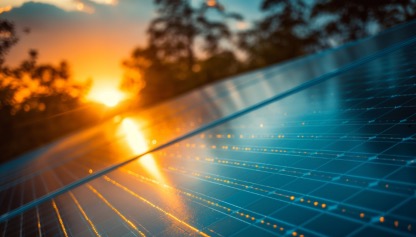Different types of photovoltaic modules differ in their core materials and technological principles, which directly lead to significant differences in their performance (such as conversion efficiency, weather resistance, and temperature coefficient). The following is a performance comparison of mainstream photovoltaic module types:
I. Crystalline Silicon Photovoltaic Modules (Market Mainstream, Over 90%)
Crystalline silicon modules are based on silicon wafers and are categorized into monocrystalline and polycrystalline silicon based on the silicon crystal structure. They are currently the most widely used type.
1. Monocrystalline Silicon Modules
l High conversion efficiency: Currently, mass production efficiencies can reach 23%-26% (laboratory efficiencies are even higher), making them one of the most efficient types of modules. They generate more power per square foot, making them suitable for applications with limited space (such as rooftops).
l Low temperature coefficient: Typically between -0.30% and -0.35%/°C, resulting in minimal efficiency degradation in high-temperature environments and more stable performance in summer or tropical regions.
l Long lifespan: Designed for a lifespan of 25-30 years, with a low degradation rate (≤2% in the first year, ≤0.5% per year thereafter).
l Good low-light response: Under low-light conditions such as cloudy days or early morning/evening, its power generation efficiency is superior to that of multicrystalline silicon.
2. Multicrystalline silicon modules
l Moderate conversion efficiency: Mass production efficiency is approximately 18%-22%, 3-5 percentage points lower than that of monocrystalline silicon, resulting in lower power generation for the same area.
l High temperature coefficient: Typically between -0.38% and -0.42%/°C, with efficiency degradation more pronounced at high temperatures, making it suitable for cool climates.
l Long lifespan: Designed for a 25-year lifespan, with degradation of ≤3% in the first year and ≤0.7% per year thereafter, a rate slightly faster than that of monocrystalline silicon.
l Simple manufacturing process: Lower requirements for light uniformity, and slightly better shadow resistance than monocrystalline silicon (but still weaker overall).

I. Thin-film photovoltaic modules (niche but highly adaptable to various scenarios)
Thin-film modules are made by depositing semiconductor thin films (such as cadmium telluride and copper indium gallium selenide) on substrates such as glass and plastic. They are only micrometers thick and operate differently from crystalline silicon modules. 1. Cadmium Telluride (CdTe) Thin-Film Modules
l Moderate conversion efficiency: Mass production efficiency is approximately 16%-18%, lower than crystalline silicon but higher than other thin-film types.
l Low temperature coefficient: approximately -0.26% to -0.30%/°C, with excellent high-temperature performance, suitable for high-temperature areas such as deserts.
l Moderate low-light response: However, strong radiation resistance makes it suitable for curved and light-transmitting designs in building-integrated photovoltaics (BIPV).
l Short lifespan: Designed for 20-25 years, with a slightly higher degradation rate than crystalline silicon (approximately 3% degradation in the first year).
2. Copper Indium Gallium Selenide (CIGS) Thin-Film Modules
l High conversion efficiency: Mass production efficiency is approximately 17%-20%, close to that of polycrystalline silicon, and laboratory efficiency can reach 23%.
l Flexibility: Flexible modules can be manufactured (e.g., thin film over a plastic substrate), suitable for curved roofs, RVs, tents, and other custom-shaped applications.
l Good weather resistance: Corrosion and impact resistance make it suitable for coastal and high-humidity environments.
l Medium temperature coefficient: approximately -0.32% to -0.35%/°C, with high-temperature performance superior to polycrystalline silicon.
3. Amorphous Silicon (a-Si) Thin-Film Modules
l Low conversion efficiency: only 6%-10%, subject to "light-induced degradation" (efficiency drops rapidly by 10%-30% after initial illumination), and unstable long-term performance.
l Advantages: Excellent low-light response (suitable for indoor or low-light environments), extremely low cost, and can be made into transparent modules (for window glass).
II. Perovskite Photovoltaic Modules (Next-Generation Potential Technology, Not Yet Commercially Available on a Large Scale)
Perovskite is a new organic-inorganic hybrid material that has seen significant research and development in recent years and is currently in the transition phase from laboratory to mass production.
l High conversion efficiency potential: Laboratory efficiency has exceeded 31%, far exceeding that of crystalline silicon, and can be further increased to over 35% through lamination technology (combined with crystalline silicon).
l Flexible and Thin: Flexible and translucent modules can be made, suitable for applications such as BIPV and wearable devices.
l Disadvantages: poor stability (lifespan is only a few thousand hours, far less than the 25 years of crystalline silicon), easily decomposed when exposed to water, and currently not commercially available.
Sun Earth Solar produces superior Solar Panels, Photovoltaic System, renowned for their superior efficiency and durability. These products consistently exceed industry standards and undergo rigorous quality inspections. The Sun-Earth team's expertise ensures customized solutions, and their commitment to sustainability, aligned with global green goals, makes Sun Earth a trusted partner.
Ningbo Sun Earth warmly welcomes you to contact us. Whether you would like to inquire about our solar panels, require detailed technical specifications, explore partnership opportunities, or have any other inquiries, our dedicated team is ready to provide prompt and attentive assistance. Feel free to contact us by phone, email, or visit our website – we look forward to hearing from you!
Keywords:
Sun Earth Solar, Ningbo Sun Earth, Sun-Earth, Sun Earth, photovoltaic modules, solar panels, Photovoltaic System


